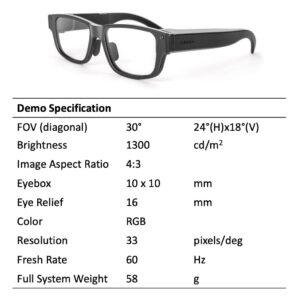To improve the accessibility of our content, please find the audio version of this blog post.
ST will take part in the MWC Shanghai 2021 that will take place between February 23 and 25. We will have a physical and virtual booth to better tailor to various circumstances. Our presence will revolve around Smart Mobility, Power and Energy Management, as well as IoT and 5G. As more members of the industry start to meet again in person, we wanted to bring meaningful demos. Each shows the progress we’ve made over the past year and reflects where the industry is heading. Hence, this blog post will focus on three applications: laser beam scanning for augmented reality (AR) glasses, STPay-Mobile, and the BlueNRG-LP. However, our Mobile World Congress booth will hold more than a hundred demos and presentations.
MWC Shanghai 2021: First Physical Demo of ST’s Latest Laser Beam Scanning Solutions for AR Glasses
MWC Shanghai 2021 is a unique opportunity to see ST’s latest laser beam scanning for a near-to-eye display technology demonstrator. Introduced at our virtual CES event, the AR glasses will be physically present, enabling attendees to test them. To reduce cross-contamination from hard surfaces, the glasses will remain on a pedestal. However, people visiting our booth will be able to see through them to experience the image’s sharpness. They will also witness the small size of the overall eyewear. Additionally, we will have a virtual demo for those attending online. In early 2020, ST showed a similar system during XR Day Live! at the University of Washington. The version on display at MWC Shanghai is more compact and brighter thanks to continual developments that reflect the work and innovations achieved in a short time and despite the global pandemic.
Addressing Key Challenges

A conference like the Mobile World Congress Shanghai is an important event because it helps leaders figure out industry challenges. For instance, there are several significant issues around augmented reality such as power consumption, form factor, brightness, and ambient contrast ratio. ST’s laser beam scanning demo provides solutions to these issues and helps attendees see why they matter. Addressing these challenges enables broad applications in the display of informatics and related information whether for professional, industrial, or prosumer applications.
Demonstrating the Form-Factor
The glasses on display demonstrate technical innovations that improve the form factor and make the overall design more practical. For instance, we integrated a new laser diode module developed by our partner OSRAM into the ST laser beam scanning optical light engine to get a more compact system. Additionally, when used in conjunction with ST’s advanced Laser Diode Driver, the optical light engine offers significant performance improvements. Such a gain is possible thanks to the driver’s rise/fall time of less than 500 picoseconds. Its unique performance enables sharper images, efficient modulation schemes, and lower power consumptions.
ST also coupled the light engine into a diffractive waveguide from our partner Dispelix to achieve very high brightness, attractive design, and overall performance. It makes the glasses more practical by delivering a larger eyebox that mitigates the need for a special fitting and measurements to adapt to the user’s facial morphology, something that competing models often require. With this new system, anyone can pick up the glasses and enjoy a clear image.
Creating an Ecosystem
The demonstration shows MWC Shanghai attendees a glimpse of the future of AR glasses. The technology demonstrator on display encapsulates all the necessary technologies, devices, systems, and solutions to enable the creation of end products. To that end, ST created and developed an enabling ecosystem through the creation of the LaSAR Alliance. Some of its four co-founding members (OSRAM, Dispelix, Applied Materials, and Mega1) already greatly impacted the eyewear demo on display at the conference. Now, the open alliance will continue to grow by adding members that provide new and critical solutions. Hence, the ST demo shows that end product designers and developers have what they need for manufacturing and for rapidly bringing AR wearable products to market.
MWC Shanghai 2021: First Announcement Around STPay-Mobile
The Diversity Dilemma
The Mobile World Congress is an opportunity to tackle new mobility challenges, such as mobile payment systems. The technology itself is now mature, and many smartphones or cards enable contactless transactions beyond simple banking. For instance, public transport organizations are switching to contactless applications for their financial and pragmatic advantages. The ability to add funds to a card through an app or to keep all cards in a virtual wallet inside a smartphone has a lot of traction. Unfortunately, countries often have diverging standards, making it difficult for a manufacturer to export its solution worldwide. Hence, ST will announce, at MWC Shanghai 2021, a solution to this dilemma in the form of STPay-Mobile.
Focusing on Services and Their Implementations
STPay-Mobile is a partnership program that invites technology providers to integrate their solutions onto our ST54 platform. It’s a way to rapidly add an upper service layer on top of ST’s system and expand a platform’s reach. For instance, we will show how Chinese smartphone makers with virtual wallets can now use their system with digital public transit cards from Spain, France, or Moscow, among others, thanks to ST’s support of open standards like Calypso, ITSO, and OSPT as well as proprietary ones such as MIFARE Classic, MIFARE DESFire 2, MIFARE Plus, and more. Traditionally, competing solutions only support a few card technologies, creating issues for engineers looking to penetrate other markets.

Another reason STPay-Mobile represents a solution for platform providers is ST’s partnership with Snowball Technology. Snowball’s virtualization platform, OnBoard, already allowed 50 transit organizations across more than 120 cities to launch virtual transit cards. Hence, adopting STPay-Mobile means that engineers gain access to numerous transportation services moving toward digitalization. Similarly, the STPay-Mobile framework will receive approvals from MasterCard and Visa, thus providing engineers with a turnkey solution and a certified SDK. As a result, STPay-Mobile can handle significant challenges that take place behind-the-scenes to hasten developments and avoid tedious and numerous recertification processes while enabling companies to go after international markets.
MWC Shanghai 2021: First Physical Demo Running 128 Connections on a BlueNRG-LP
Connecting 128 Devices in Real Life
Trade shows like MWC Shanghai 2021 represent a fantastic opportunity to test unique features in ways that few can experience. One of the best examples of that is our demo of the BlueNRG-LP. The new SoC launched at the end of 2020, supports up to 128 connections. It is also ST’s first Bluetooth Low Energy 5.2 certified device. It offers a 2 Mbps throughput, a long-range mode that can reach 1.3 kilometers (0.8 miles). Moreover, it has the best link budget in the industry. However, out of all these features, very few will ever have the chance to test the ability to connect 128 devices. Hence, our demo at MWC Shanghai 2021 will include a BlueNRG-LP module connected to a wall of 128 devices simultaneously.
Ensuring Interoperability and Stability
The event will also allow us to hammer the importance of interoperability as well as stability. Indeed, some manufacturers in China did struggle in the past with competing devices that didn’t behave properly with certain phones or products, for instance. It’s also a problem for companies and customers because they can’t fully use their end product. Hence, the event will enable us to explain how ST ran extensive compatibility tests on more than 200 devices from the top 20 smartphone vendors to guarantee our SoC’s compatibility with all of them. Engineers, therefore, can have confidence that their system will work with the vast majority of the Bluetooth ecosystem already in the field.
MWC Shanghai will also allow attendees to jump in on new wireless trends, such as Bluetooth mesh. Indeed, now that the standard is a few years old, more companies are starting to adopt it. ST’s BLE stack offers an optimized, upgradable and robust implementation that can help engineers create products that take advantage of this new technology. Our software also uses a smaller memory footprint compared to competing solutions and we aim to lower the barrier to entry. For instance, the STSW-BNRG-Mesh enables developers to install demo applications and start testing code in minutes. It’s often the first step when developing a proof-of-concept. Engineers can look at ST’s source code and send test packets. Additionally, attendees can talk to ST experts to receive advice, answers, and assistance.
